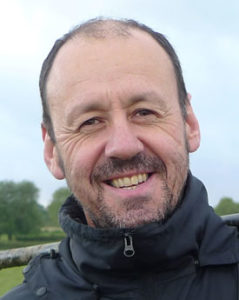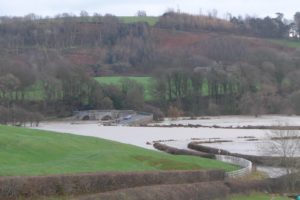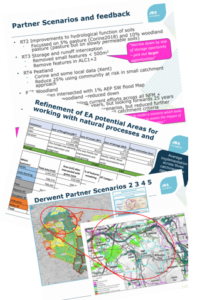Working with local partners to develop and refine Q-NFM research and modelling scenarios
Professor Phil Haygarth, Lancaster University

Phil and his family were directly impacted by the flooding caused by Storm Desmond in 2015. They live in the Lune valley near Lancaster and were cut off by flood waters , an experience Phil describes in a blog here. “I would hate to go through that again,” Phil recalled, “and being affected by it made it visceral – more personal and more real, and importantly, brought home the need to connect with others who have been affected, often much worse than me. It also gave me determination to seek solutions.”

Flooding in the Lune Valley, December 2015, Phil Haygarth
Phil’s areas of expertise include soil, water quality and quantity and is a contributor to Lancaster’s Q-NFM research project. Explaining how he became involved with Q-NFM’s he said: “I have been working in the Eden catchment which is nestled between the Lake District and the Pennines in NW England for more than 10 years. Much of this work has included managing collaboration between scientists and partner organisations including farmers, Defra and the Environment Agency. Nick Chappell, who leads Q-NFM was keen to use similar approaches”
Phil emphasised how important team working has been and acknowledged the contribution of the Rivers Trust, in particularly Dave Johnson, Catherine Mcllwraith, Lucy Butler. Others from the Q-NFM team Nick Chappell, Trev Page and Barry Hankin from JBA Consulting have been heavily involved.
“The team have been working to make the best of our contacts with partners in the catchment through engagement and co-design to develop properly informed locally owned solutions. Our goal was to co-develop flood management scenarios including NFM measures, to prioritise what to investigate in more detail. The engagement process we adopted had two phases.”
“Firstly, the National Rivers Trust team led discussions with local partners (such as local Rivers Trusts and Catchment Managers in flood-affected areas of Cumbria) in Autumn 2019 to build a perspective on what was needed. This involved structured discussions and exercises; it was very much interviewing and listening, and the information was used to develop outline scenarios for flood management for more detailed later consideration.”
“The second phase was a stakeholder event in January 2020, just before Covid hit. It was a buoyant interactive meeting at which the refined scenarios were discussed and evaluated with some 50 local partners. We co-developed 5 realistic scenarios drawing on Q-NFM modelling input, Environment Agency maps and local partner understanding of flooding patterns and impact. A live electronic voting system worked well in eliciting views on preferred approaches. We held small group discussions to explore issues in more detail. We also visited field and experimental sites together.”

The iteration, feedback and discussion allowed the research team to refine scenarios and agree a manageable set of options to consider in more detail, drawing on locations where computer modelling identified NFM interventions were likely to be effective.
Reflecting on the process, Phil observed: “this was the first time we have collated data in this way to inform research. From my previous experiences of working with local partners I know that for it to work we have to build trust on both sides and this takes commitment and time, but does elicit much better outcomes.”
He is certain that the planning and organisation that preceded the workshops was essential. “Structuring of discussions with a strong biophysical lead, provided principally by the Q-NFM modelling team was critical to the success of the work. We encouraged the community to speak freely, but I believe the structured nature of the discussions was essential to eliciting the information that has been so useful in shaping and refining our research.”
Another important factor, Phil explained: “was the unfortunate fact that local communities had recently experienced flooding, which heightened their interest in the topic and probably helped bring an already tight community closer together. I think this made them even more willing to contribute to our research.”
On the impacts of Covid and looking forward, he observed: “We were doing well but the global pandemic has slowed things down. We would like to provide further opportunities for local involvement and share how we have progressed; it’s important not to leave people wondering what happened to their input.”
“In the longer term, some of the questions we would like to address are how can we roll out the co-design process at regional and national scales.”
“My personal experience of flooding has made me more determined to seek flood risk solutions that benefit people and the environment.” He also said he supported “an interesting suggestion put forward by the Rivers Trust that we should seek to understand better how to draw on the energy of communities drawn together by the experience of flooding to improve flood risk management for the future.”
Contact Phil Haygarth: p.haygarth@lancaster.ac.uk
A recording of Phil presenting on this work is available here, alongside recordings of other talks that were given at our Novel Communications Workshop held online in December 2020.
Read a JBA Consulting blog on Q-NFM research here.

